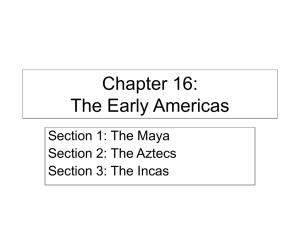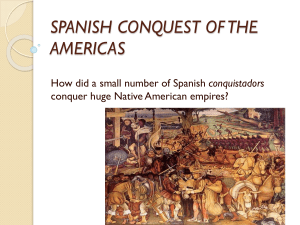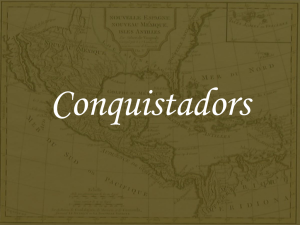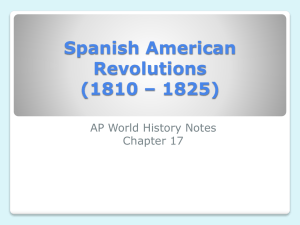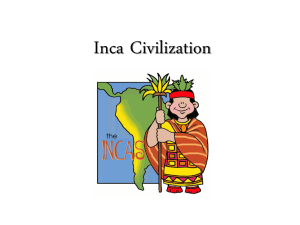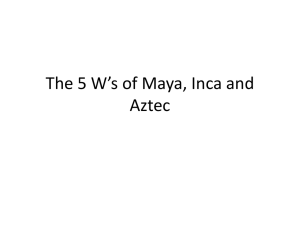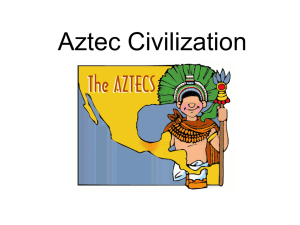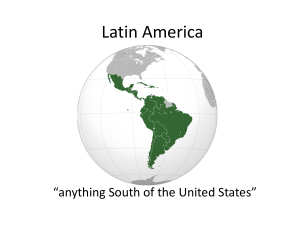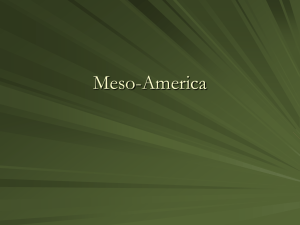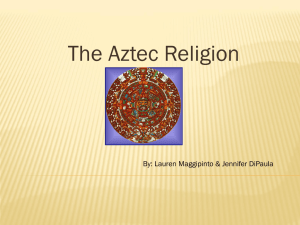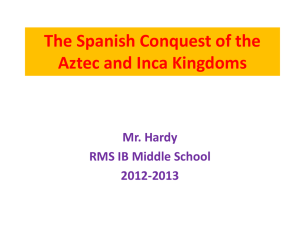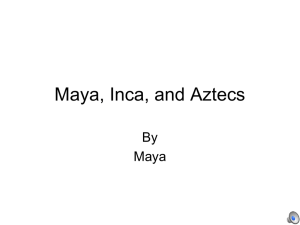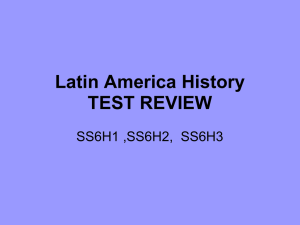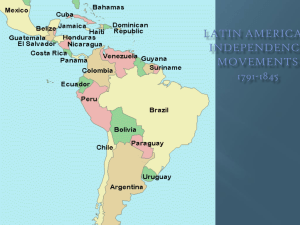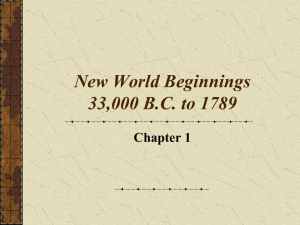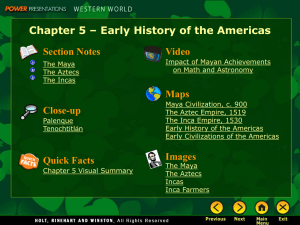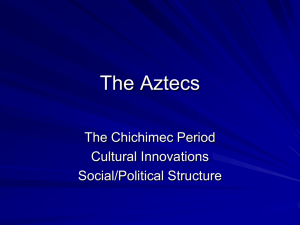Chapter 12 - OCPS Teacher Server
advertisement
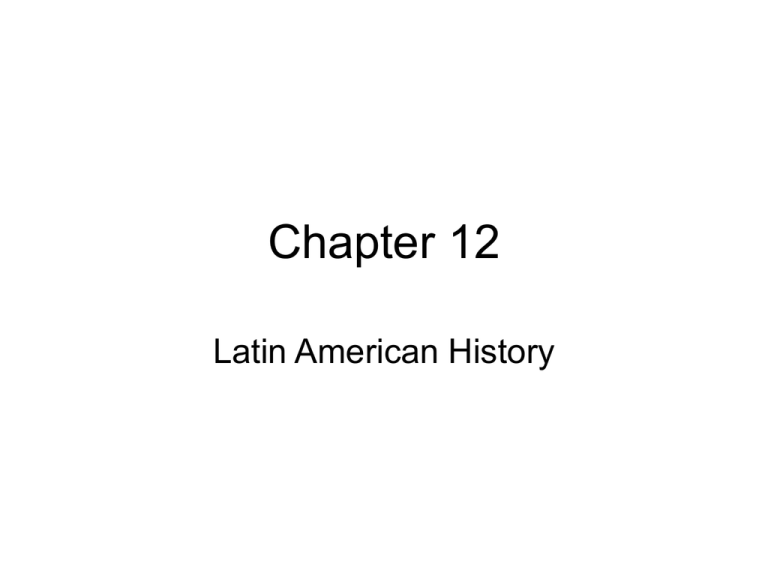
Chapter 12 Latin American History Pre-Columbian America • Christopher Columbus arrived in the Americas in 1492 and found a world very different from his world in Europe, he and many other Europeans that followed him felt that the Native American were sub-human and were not on the same level of the Europeans • The truth was that the Native American societies were as advanced as the Europeans and more advanced in some areas • Maya: a tribe of Native American that dominated the southern part of Mexico from 250 – 900 CE • Sometime after approximately 900, the Mayans disappeared and were no longer a power in Central America • The Mayan civilization was the first to identify the number 0, and to recognize that there are 365 days in a year and they used a language based on system of hieroglyphics • Hieroglyphics: a system of writing using signs and symbols Mayan Empire Chichen Itza Chichen Itza Chichen Itza Aztec • The Aztecs stepped onto the scene in Mexico around 1200 and in 1325 they built the capital city of Tenochtitlan • Aztec: Native American tribe that dominated Mexico from the 1300’s until the Spanish Conquest • Tenochtitlan: the ancient Aztec capital and site of Mexico City today • the ancient Aztec capital and site of Mexico City today • The Aztecs were one of the most advanced civilizations on earth, with the city of Tenochtitlan having a population of over 200,000 people • The Aztecs did practice human sacrifice and in one 4 day feast period they sacrificed over 2,000 people to the gods Aztec Empire Human Sacrafice Aztec Warrior Huitzilopochtli – God of the Aztecs Aztec Calendar The Incas of South America • While the Aztecs and Mayans dominated Mexico and Central America, the Incas dominated South America • Inca: peoples of South America who built a civilization in the Andes Mountains in the 15th and 16th centuries • The Incas built their capital at Cuzco in Peru, and their empire ran for over 2,500 miles and they built the first system of roads in South America • Cuzco: a village in the Andes that became the Incan capital • The Incas were lead by their strong emperor named Topa Inca, and he helped build up their empire • Topa Inca: Emperor of the Incas • Like the Mayans the Incas developed things unseen anywhere in the world including the world’s first census • Census: an official count of all the people in an area and how they make a living at • Quipus: knotted strings on which they recorded information Manchu Picchu Inca Empire Inca flute player Life of the Incas • The Incas had their own language which is still spoken in Peru, Bolivia and Chile • Quechua: the language of the Inca Empire now spoken in the Andes highlands • The Incas created a system of roads to spread information and goods throughtout its empire and a system of aqueducts to send water to the people • Aqueducts: a pipe or channel that carries water from a distant source • Like the Aztecs and Mayans the Incas were polytheistic and worshipped multiple gods but the god Viracocha was the creator of the gods The coming of the Europeans • The Europeans started coming to the Americas in 1492 when Christopher Columbus thought he got to Asia but instead he “Found” a whole New World • Christopher Columbus: Italian explorer, first European to arrive in America • After Columbus arrived in America, Spain and Portugal the two great European powers split the Americas • During the 15th century, Spain and Portugal were the two largest sea powers in Europe and were doing the most exploring to stop them from fighting over the “New World” the Pope made them sign the Treaty of Tordesillas • Treaty of Tordesillas: a treaty signed by Spain and Portugal in 1494 that gave Portugal control over Brazil The Treaty of Tordesillas Treaty of Tordesillas The Conquering of the Natives • In 1519 Spanish explorer Hernando Cortes landed on the coast of Mexico and then moved inland • Cortes made alliances with other native tribes opposed to the Aztecs and when he was received by Moctezuma of the Aztecs, they thought he was a god • Moctezuma: ruler of the Aztecs • Cortes marched into Tenochtitlan and took Montezuma prisoner, the Aztecs revolted but they were no match for the Spanish, though it took the Spanish 3 years to conquer Tenochtitlan • In 1525, six years since Cortes first landed the Spanish conquest of Mexico was complete • Cortes: conqueror of the Aztecs • Cortes and men that followed him in conquering Latin America were known as the Conquistadors • Conquistador: conquerors of Latin America Spanish vrs. Aztec Cortes Cortes gold Moctezuma’s revenge • According to legend before he died Moctezuma put a curse on the water in Mexico where as any foreigner that would drink the water would get diarrhea from it • So remember whenever you are in Mexico • DON’T DRINK THE WATER!!!!!!! The Conquering of the Incas • After Cortes went out and conquered the Aztecs, Francisco Pizzaro and 120 men overthrew the Incas • Pizzaro: conqueror of the Incas in South America • Pizzaro followed Cortes model by taking the Inca emperor prisoner, the Incas offered Pizzaro a room filled with gold and silver but Pizzaro killed the emperor and the Incas gave in • Pizzaro actually conquered the Incas with an army of less than 200 men Pizzaro Life after the conquistadors • When the Spanish came to Latin America they brought their language, culture and the Catholic religion • Many Spanish settlers also mixed with the Native Americans and a new class of people were created the mestizos • Mestizo: a person of mixed Spanish and Native American heritage • Mestizos were higher on the social order than Native Americans, but were considered lower than the white Spanish peninsulares and criollos • Criollos: people who had Spanish parents but had been born in Latin America • Many mestizos were poor but some where able to become as wealthy as the white Spanish peninsulares, • Unfortunately many mestizos and Natives worked on haciendas • Hacienda: a plantation or large farms owned by the Spaniards or the Catholic Church Independence movement • As the 1700’s drew to its close, the people who lived in Latin America were under either Spanish, Portuguese or French control for more than 200 years and they wanted to be free • The first people wanting their freedom were the slaves on France’s colony of Haiti • Toussaint L’Overture: leader of the Haitian revolution • L’Overture never lived to see Haitian independence but in 1804 Haiti became the 2nd independent nation in the Americas Toussaint L’Overture South American Independence • The people of South America were inspired by the American and French Revolutions and they wanted to throw out the Spanish • Simon Bolivar: Liberator of Colombia, Venezuela, Ecuador and Bolivia • Jose de San Martin: Liberator of Argentina, Chile and Peru • Even though Bolivar and San Martin were believers in democracy and the right of the people to rule, in many South American countries authoritarian dictators took over and trampled the rights of the people known as caudillos • Caudillo: military officers who ruled strictly Bolivar Jose de San Martin After Independence: • After gaining independence from their colonial rulers many of the nations of Latin America were left with weak inexperienced rulers who then turned to the military for help thus many caudillos became dictators • Dictator: rulers with complete power • Many times the dictators were overthrown by a new ruler who promised democratic change but instead a dictator took over • To support themselves the people of Latin America made money off selling their goods such as bananas and coffee • Export: to send products from one country to be sold in another • Unfortunately the nations of Latin America were very dependant on the nations of Europe and US for manufactured goods known as imports • Import: is to bring products into one country from another Foreign involvment • To support themselves many Latin American nations were forced to have foreign nations and their businesses invest in their nations • The United States became heavily involved in Latin America, especially in 1904 when the American government wanted to build the Panama Canal • Thus because of US investing in their nations, the countries of Latin America accumulated a lot of foreign debt • Foreign debt: money owed to other countries Reforms of the nations • To enforce their help pay of their debts the nations of Latin America began to make reforms to help pay off their debts and new regimes took over in many nations • Regime: a particular administration or government • These new regimes said that they were not responsible for their debts and they could start over again
